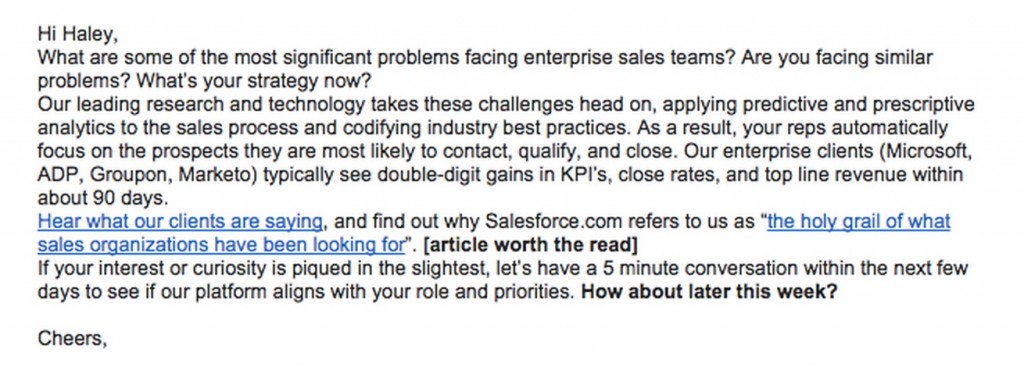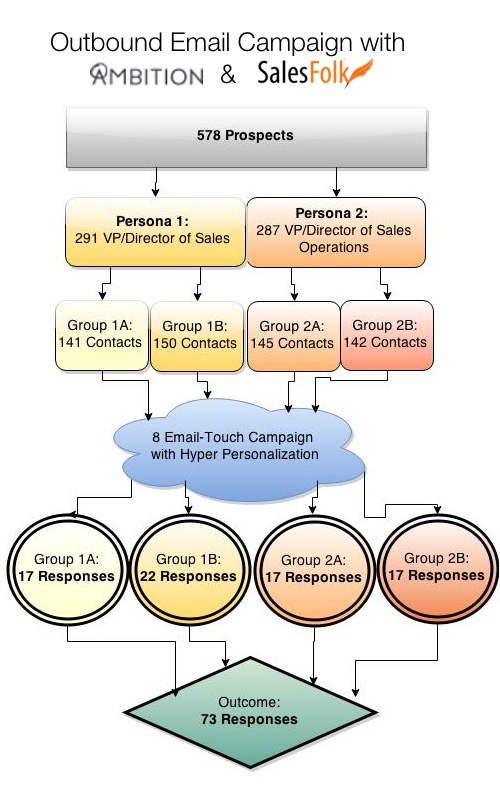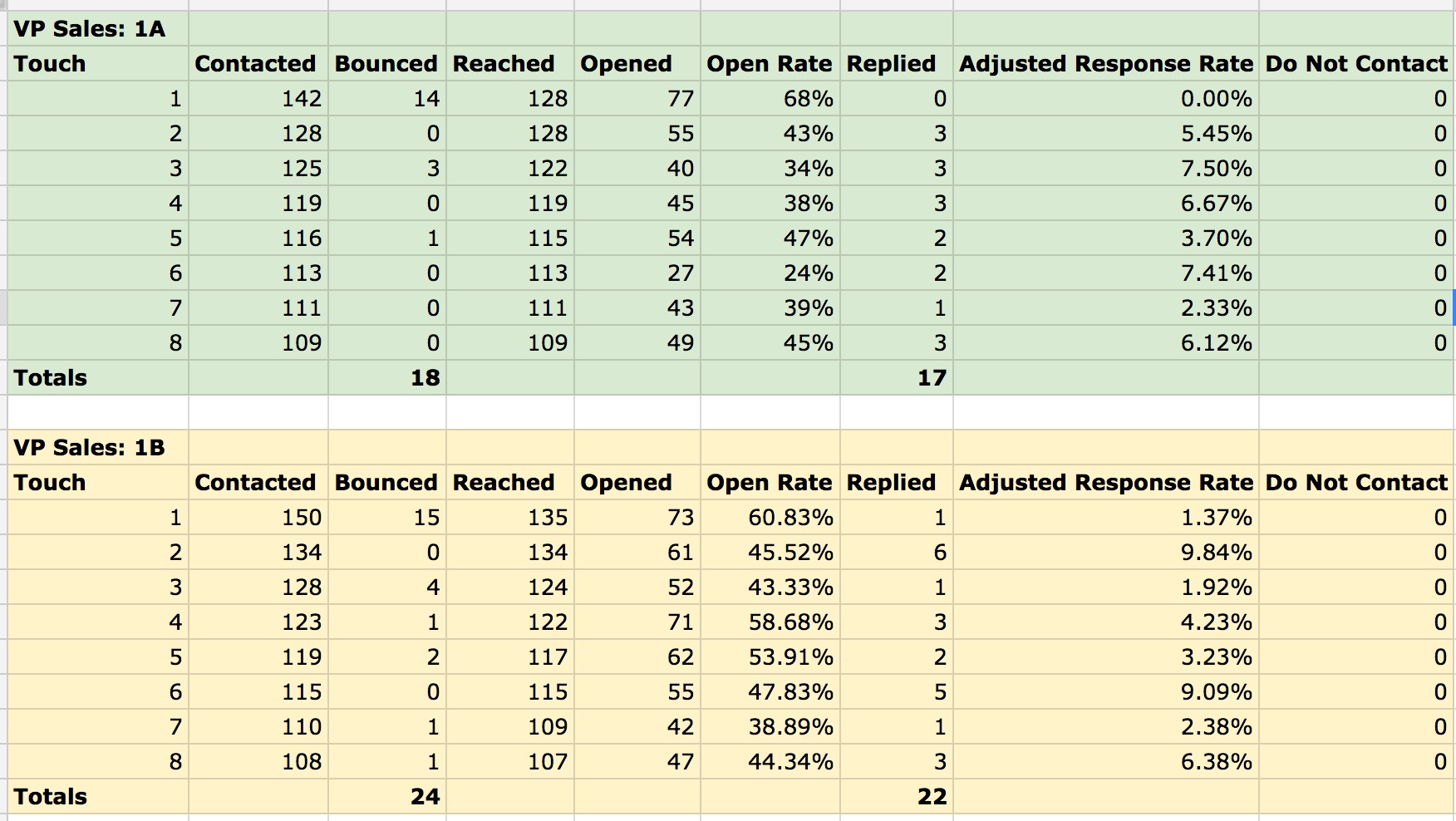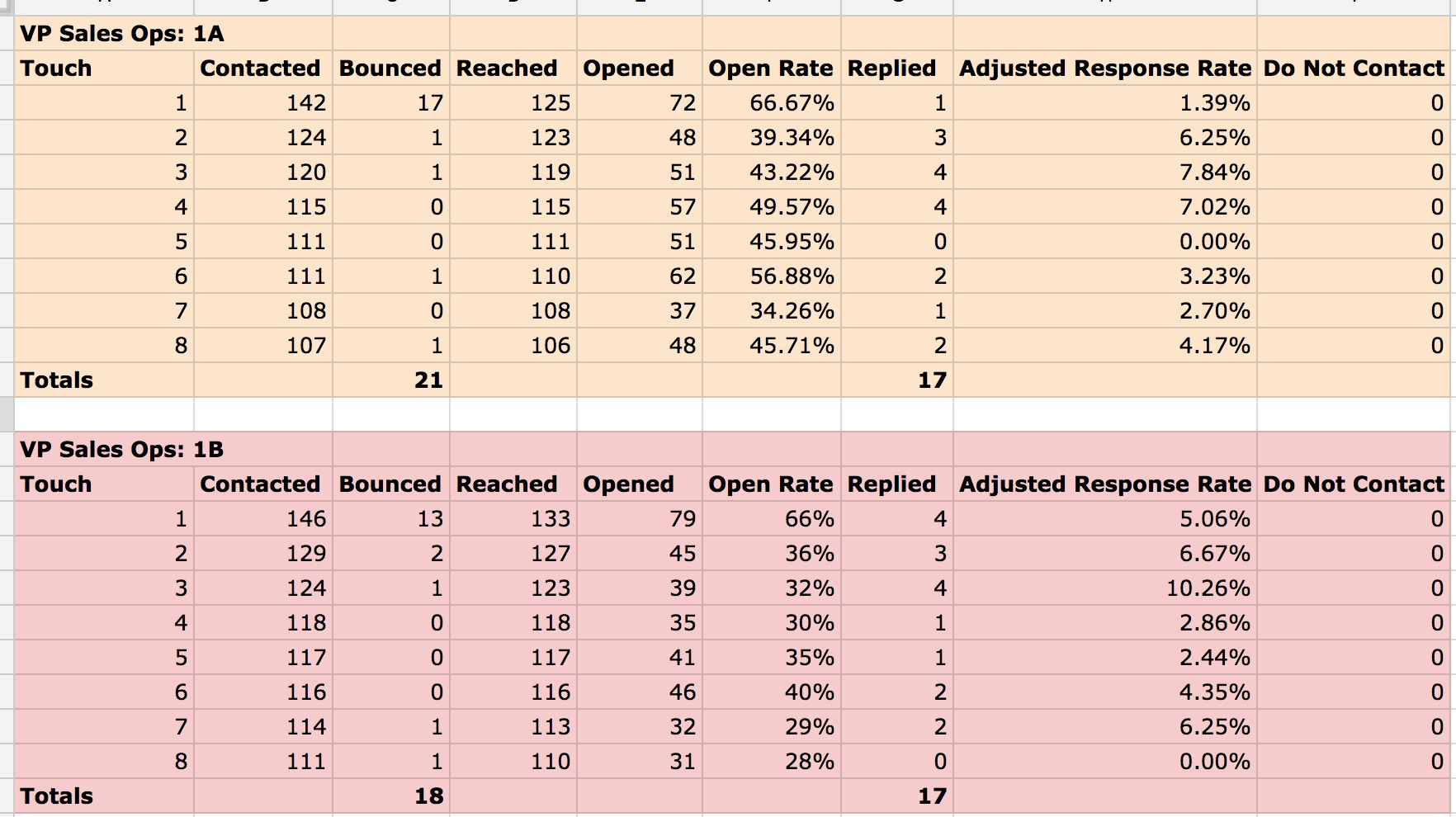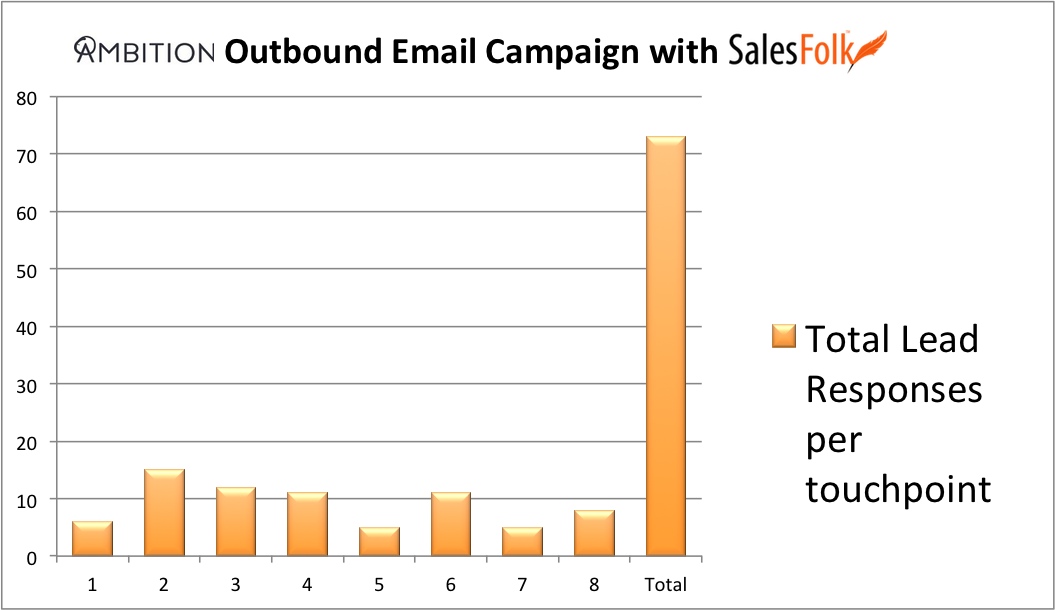Not all the cold emails I receive go straight to my “bad cold emails” file. Some have just enough promise to make me take a second look.
You might have a killer benefit-focused message, but if your call to action is weak or you’re bombarding your prospects with excessive information, your cold emails will fail to make an impact.
My cold email critique this week focuses on how you can make minor tweaks in your messages to craft an amazing cold email that impresses your prospects.
If your emails are in decent shape, but could use some extra polishing, follow this advice. These DOs and DON’Ts can help you transform your good cold emails into kick ass messages that pack a punch.
This email was sent to the Salesfolk team:
Cold Email Tip #1: Do engage your prospects with a thought provoking question.
What are some of the most significant problems facing enterprise sales teams?
If you want your cold emails to stand out from the all the other emails filling up your prospects’ inboxes, you need to find a way to make them notice you. Your prospects probably receive dozens of emails every day. The emails that grab the most attention are the ones that make them stop and think.
Your cold emails should be the start of a conversation with your prospects. Instead of throwing out a list of all your product’s features right off the bat, try warming them up with a thought provoking question.
Ask your prospects a question that is relevant to both your product and their business. Make them think about their business and the areas that can be improved. Once you can get them to recognize there’s a problem, it’s easier to offer your prospects a solution.
This question could be a little bit more thoughtful or specific, but it’s not a terrible start.
Cold Email Tip #2: Don’t bombard your prospects with too many questions or ideas
Are you facing similar problems? What’s your strategy now?
Asking too many questions can confuse your prospects and distract from your message.
Limit your cold email introductions to one or two sentences. Remember, the goal is to get your prospects to think about one specific idea, benefit or pain point. If you make them think too much, they’ll lose interest and stop reading.
Whether you use a question or not, your first sentence should be highly focused and conversational. Your aim is to solve your prospects’ problems, but you need to do one thing at a time to be effective.
Cold Email Tip #3: Show that you can add value to your prospects’ lives
Our leading research and technology takes these challenges head on, applying predictive and prescriptive analytics to the sales process and codifying industry best practices.
Your prospects probably aren’t responding to most of the cold emails they receive because they’re way too self-focused and feature-driven. They aren’t geeking out with you about all the bells and whistles your product has to offer.
Your prospects crave messages that speak to them and their unique needs. Show them that you understand them and the issues they face on a daily basis. Offer them benefit-focused messages that show your prospects how your product can improve their business and make their lives easier.
This sentence would be better if it explained more concretely how this company was able to benefit their clients, and it would be ideal if they could quantify the impact of these benefits.
Perhaps it would be more relatable and credible if it said something like:
“We helped Client X’s reps close deals 3x faster by comparing their sales process against industry best practices to spot inefficiencies that were holding back their sales cycles.”
When your prospects relate to your message, they’re more likely to take notice and respond.
Cold Email Tip #4: Don’t be vague about how your benefits
Our leading research and technology takes these challenges head on, applying predictive and prescriptive analytics to the sales process and codifying industry best practices. As a result, your reps automatically focus on the prospects they are most likely to contact, qualify, and close.
Don’t just list the benefits of your product; add context to your messages so your prospects can clearly see how your product can help them.
While this example does highlight potential benefits to customers, it doesn’t connect with the bottom line benefit, which I assume, is optimizing sales cycles/processes to close more deals faster.
However, they do say that their “enterprise clients typically see double-digit gains in KPI’s, close rates, and top line revenue within about 90 days.”
That is a solid benefit, but they should focus on that idea more and build out that message to be the center of their “Social-Proof” sentence.
You need to make it dead simple for your prospects to understand your product’s biggest value to them if you want them to respond.
Cold Email Tip #5: Backup your claims with proof that your product actually works.
Our enterprise clients (Microsoft, ADP, Groupon, Marketo) typically see double-digit gains in KPI’s, close rates, and top line revenue within about 90 days.
Doing business is full of risks for your prospects. Including supporting evidence like this not only helps to prove the effectiveness of your product, but also helps to ease your prospects’ doubts.
Social proof, like case studies and performance statistics, builds trust and credibility with your prospects and shows that you can back up your claims.
Name dropping a few satisfied clients like, “Microsoft, ADP, Groupon, Marketo,” offers your prospects the promise of future value. When your prospects can see that other companies have benefited from your product, it makes investing their time and money with you less risky.
Cold Email Tip #6: Don’t distract your prospects with articles, videos or external links.
Hear what our clients are saying, and find out why Salesforce.com refers to us as “the holy grail of what sales organizations have been looking for”. [article worth the read]
Your prospects don’t have time to read through pages of information about your product.
The longer your message drones on, the more likely your prospects will get bored and give up on you. Keep your emails laser focused. The goal is only to get your prospects on the phone. You don’t need to educate them on every single feature and benefit your product has to offer just yet.
Adding external links or PDFs can be a fatal mistake. Any time you take your prospects away from your message, you risk losing them for good.
Don’t worry about giving your prospects all the facts at once. You can explain your product in greater detail once you’ve got them on the phone.
I’m not 100% against including any links whatsoever, but cold emails are not drip email marketing campaigns. You should not rely on prospects to click a link to be interested in your product; your copy must do that. Links are just a “cherry on top,” but alone are not enough substance to get someone to respond. When I do include links in email campaigns, it’s usually in the “PS” of a later email, or in a breakup email.
Cold Email Tip #7: Do set a time limit to your phone conversations
If your interest or curiosity is piqued in the slightest, let’s have a 5 minute conversation within the next few days to see if our platform aligns with your role and priorities.
The thought of getting stuck on the phone listening to another boring long-winded sales pitch doesn’t excite anyone. You need to make the next step as easy and enticing as possible for your prospects.
It’s easier to get someone on the phone when they know you’re only going to only take 5-10 minutes of their time. This approach is less threatening than asking your prospects to commit to a demo or a phone call that might take up the entire afternoon.
Cold Email Tip #8: Don’t forget to reward & incentivize people for their time
How about later this week?
Believe it or not, your prospects aren’t jumping for joy to hear you talk about how wonderful your product is. They need to know that there’s something in it for them as well.
The problem with this call to action is that it doesn’t offer us anything in exchange our their time.
If you want to move your prospects to action, you need to incentivize your CTA. Offering a few actionable tips or a piece of valuable information suddenly makes a phone call with anyone’s time.


